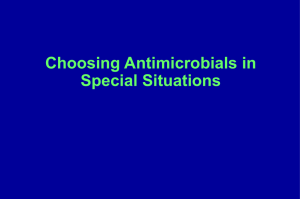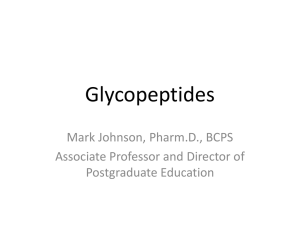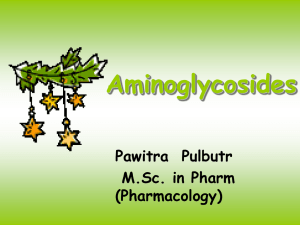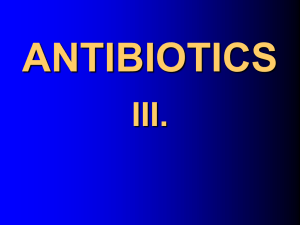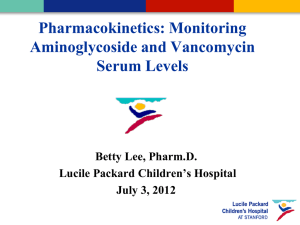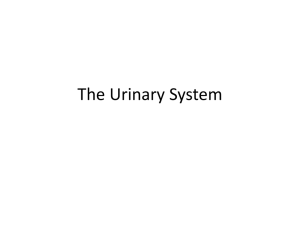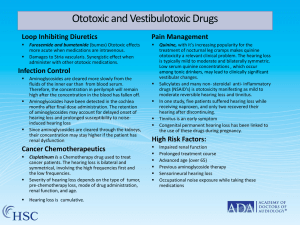Review of ATB Part 1
advertisement
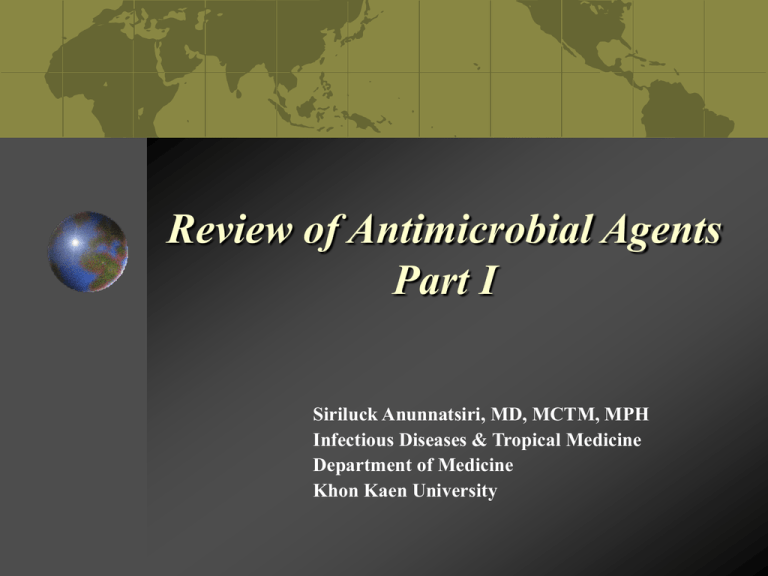
Review of Antimicrobial Agents Part I Siriluck Anunnatsiri, MD, MCTM, MPH Infectious Diseases & Tropical Medicine Department of Medicine Khon Kaen University Classification of Antimicrobial Agents -lactam antibiotics: Penicillins, Cephalosporins, Carbapenems, Monobactams, -lactam/-lactamases inhibitors Aminoglycosides Macrolides Ketolides: Telithromycin, Dirithromycin Lincosamides: Lincomycin, Clindamycin Quinolones Chloramphenicol Classification of Antimicrobial Agents Tetracyclines, Tigecycline Sulfamethoxazole/Trimethoprim (SMX/TMP) Glycopeptides: Vancomycin, Teicoplanin Oxazolidinones: Linezolid Fosfomycin Fusidic acid Polymyxins: Polymyxin B, Colistin Metronidazole Classification of Antimicrobial Agents Lipopeptide: Daptomycin Streptogramins: Quinupristin-Dalfopristin -lactam antibiotics Aminoglycosides Glycopeptides Antimicrobial Properties Structure Spectrum Mechanisms of action Mechanism of resistance Pharmacokinetic Absorption Distribution Metabolism Elimination Pharmacodynamic Drug interaction Side effect Beta-lactams Antibiotic: Basic Structure Aminoacyl Thiazolidine ring Hydroxyethyl Dihydrothiazine ring Beta-lactams Antibiotic: General Properties Inhibit cell wall synthesis Bactericidal effect Time-dependent bactericidal action Inoculum effect on antimicrobial activity is more prominent In GNB - No or short PAE for most -lactam Share -lactam class allergic reaction except monobactams PD Parameters affecting Antibiotic Potency AUC/MIC >125 for GNB >25-50 for GPC Cmax/MIC >10 > 40-50% of dosing interval Inoculum Effect The effect of inoculum size on antimicrobial activity Dense population can be less susceptible to -lactams Failure to express receptor (PBP) High concentration of -lactamases Trend to presence of resistant subpopulation Postantibitic Effect A persistent suppression of growth after levels have fallen below the MIC Bacterial Cell Wall Synthesis Hiramatsu K. Lancet Infect Dis 2001; 1: 147-155 Bacterial Cell Wall Synthesis (Transpeptidase) Hiramatsu K. Lancet Infect Dis 2001; 1: 147-155 Beta-lactams Antibiotic : Mechanism of Action Hiramatsu K. Lancet Infect Dis 2001; 1: 147-155 Beta-lactams Antibiotic : Mechanism of Resistance -lactamases destruction of antibiotic Failure of antibiotic to penetrate the outer membrane of gram-negative to reach PBP target Efflux of antibiotic across the outer membrane of gram-negative Low-affinity binding of antibiotic to PBP target Beta-lactams Antibiotic: Adverse Reactions • Hypersensitivity – 3 to 10 % • Irritability, jerking, confusion, seizures– especially with high dose penicillins and imipenem • Leukopenia, neutropenia, thrombocytopenia – therapy > 2 weeks • Interstitial nephritis • Cephalosporin-specific: cefamandole, cefotetan, cefmetazole, cefoperazone, moxalactam Hypoprothrombinemia - due to reduction in vitamin K-producing bacteria in GI tract Penicillins: Classification Natural penicillins Penicillin V, Penicillin G Aminopenicillins Ampicillin, Amoxicillin Penicillinase-resistant penicillins Cloxacillin, Dicloxacillin, Nafcillin, Methicillin Carboxypenicillins Carbenicillin, Ticarcillin Ureidopenicillin Piperacillin, Azlocillin, Mezlocillin Natural Penicillins: Spectrum of Activity Gram-positive Gram-negative S. pneumoniae Streptococcus sp. Enterococcus sp. C. diphtheriae B. anthracis L. monocytogenes Neisseria meningitidis Anaerobes Above the diaphragm Clostridium perfringens Other Treponema pallidum Leptospira sp. Penicillinase-Resistant Penicillins: Spectrum Gram-positive MSSA MSSE Streptococcus sp. Aminopenicillins: Spectrum of Activity Gram-positive Gram-negative Streptococcus sp. Enterococcus sp. L. monocytogenes C. diphtheriae Proteus mirabilis Salmonella sp. Shigella some E. coli H. influenzae N. meningitidis Anaerobes Above the diaphragm Clostridium perfringens Carboxypenicillins: Spectrum of Activity Gram-positive Gram-negative Streptococcus sp. C. diphtheriae Proteus mirabilis Salmonella sp. Shigella E. coli H. influenzae Neisseria sp. Enterobacter sp. P. aeruginosa Citrobacter sp. Serratia sp. Anaerobes Fairly good activity Ureidopenicillins: Spectrum of Activity Gram-positive Gram-negative Streptococcus sp. Enterococcus sp. L. monocytogenes Proteus mirabilis Salmonella sp. Shigella E. coli Klebsiella sp. H. influenzae Neisseria sp. Enterobacter sp. P. aeruginosa S. marcescens Anaerobes Fairly good activity Penicillins: Pharmacology Administration – Oral, IV, IM Varying oral absorption 40% for Ampicillin 75% for Amoxicillin Varying protein binding 17% for aminopenicillin 97% for dicloxacillin More free drugs in the presence of probenecid Mainly excrete via renal tubular cells, which can be blocked by probenecid. Penicillins: Pharmacology Dose adjustment is needed when CCr < 1020 ml/min, on hemodialysis or CVVH Biliary excretion is important only for nafcillin and antipseudomonal penicillins. Well distributed to most tissues, high concentration in urine and bile Relatively insoluble in lipid and penetrate cells relatively poorly Cephalosporins: Classification 1st Generation 2nd Generation Cephamycins 3rd Generation 4th Generation Cefazolin Cefamandole Cefmetazole Ceftriaxone Cefepime Cephalothin Cefonicid Cefotetan Cefotaxime Cefpirome Cephapirin Cefmetazole Cefoxitin Ceftazidime Cephradine Cefotetan Cefoperazone Cefadroxil Cefoxitin Ceftizoxime Cephalexin Cefuroxime Cefsulodin Cefprozil Moxalactam Loracarbef Cefdinir Cefaclor Cefditoren Cefixime Ceftibuten Cefpodoxime 1st Generation Cephalosporins: Spectrum Best activity against gram-positive aerobes, with limited activity against a few gram-negative aerobes Gram-positive Gram-negative MSSA Enterobacteriaceae Streptococcus sp. 2nd Generation Cephalosporins/Cephamycins: Spectrum More active against gram-negative aerobes Cephamycin group has activity against gram-negative anaerobes including Bacteroides fragilis 3rd Generation Cephalosporins: Spectrum Increase potency against gram-negative aerobes Ceftriaxone and cefotaxime have the best activity against MSSA and Streptococcus sp. Ceftazidime, moxalactam, cefixime, and ceftibuten have less activity against MSSA Ceftazidime, cefoperazone, and cefsulodin have activity against P. aeruginosa. 4th Generation Cephalosporins: Spectrum Extended spectrum of activity gram-positives: similar to ceftriaxone gram-negatives: Enterobacteriaceae including cephalosporinase-producer, P. aeruginosa. Stability against -lactamases; poor inducer of extended-spectrum -lactamases Cephalosporins: Pharmacology Polar, water-soluble compounds Administration – IM, IV, oral, intraperitoneum High oral bioavailability Varying protein binding – 10% -> 98% Largely confined to extracellular compartment, relatively poor intracellular concentration Good CNS penetration – Only 3rd & 4th gen. cephalosporins Almost excrete via renal tubular secretion, except ceftriaxone and cefoperazone are largely eliminated via biliary route Carbapenems Imipenem N-formimidoyl derivative of thienamycin Need to combine with cilastatin to prevent renal dehydropeptidase I hydrolysis and nephrotoxic effect Meropenem, Ertapenem -1-methyl, 2-thio pyrrolidinyl derivative of thienamycin Carbapenems: Spectrum of Activity Most broad spectrum of activity of all antimicrobials Have activity against gram-positive and gramnegative aerobes, anaerobes, Nocardia sp., rapid-growing mycobacteria Bacteria not covered by carbapenems include MRSA, MRSE, E. faecium, C. difficile, S. maltophilia, B. cepacia Ertapenem not active against P. aeruginosa and Acinetobacter sp. Carbapenems: Pharmacology Absorbed poorly after oral ingestion T1/2: Imipenem, Meropenem 1 hr Ertapenem 4 hr Well distributed to body compartment and penetrate well into the most tissues Excrete via renal, dosage adjustment is required in patient with impaired renal function. Need supplement dose in patient performing CVVH, hemodialysis -Lactam/-Lactamase Inhibitor Ampicillin/sulbactam (A/S) Amoxicillin/clavulanate (A/C) Ticarcillin/clavulanate (T/C) Piperacillin/tazobactam (P/T) Cefoperazone/sulbactam (C/S) -Lactam/-Lactamase Inhibitor: Spectrum Maintain spectrum of -Lactams but enhance activity against -Lactamase (Ambler class A) producing organisms Activity against MSSA, Streptococcus sp., Enterococcus sp. (Except C/S), -Lactamase producing Enterobactericeae, P. aeruginosa (Only P/T, C/S), Anaerobes. -Lactam/-Lactamase Inhibitor: Pharmacology Clavulanate, Sulbactam – Moderately well absorbed Good tissue distribution Penetration into inflamed meninges Clavulanate, Sulbactam – Poor Tazobactam – Good in animal model Excretion Clavulanate – Lung, feces, urine Sulbactam, Tazobactam - Urine Monobactams Aztreonam Bind primarily to PBP 3 in Enterobacteriaceae, P. aeruginosa, and other gram-negative aerobes No activity against gram-positive or anaerobic bacteria Low incidence of drug hypersensitivity; no crossreaction with other -Lactams Weak -Lactamase inducer Aminoglycosides: Basic Chemical Structure Aminocyclitol Ring Aminoglycosides: Classification Family Member Streptidine aminocyclitol ring Streptomycin Spectinomycin Streptomycin 2-deoxystreptamine aminocyclitol ring Kanamycin Kanamycin, Amikacin, Tobramycin, Dibekacin Gentamicin Gentamicin, Netilmicin, Sisomicin, Isepamicin Neomycin, Paromomycin Neomycin Aminoglycosides: Mechanism of Action Aminoglycosides: Mechanism of Resistance Adenyltransferase Phosphotransferases Acetyltransferases Aminoglycosides: Spectrum of Activity Gram-Negative Aerobes Enterobacteriaceae, P. aeruginosa, Acinetobacter sp.- Kanamycin & Gentamicin groups F. tularensis, Brucella sp., Y. pestis Streptomycin, gentamicin N. gonorrhoeae - Spectinomycin Mycobacteria M. tuberculosis – Streptomycin, kanamycin, amikacin Non-tuberculous – Amikacin, streptomycin Aminoglycosides: Spectrum of Activity Gram-Positive Aerobes (In vitro synergy) S. aureus, S. epidermidis, viridans streptococci, Enterococcus sp. Nocardia sp. - Amikacin E. histolytica, C. parvum - Paromomycin Aminoglycosides: Pharmacology Bactericidal effect Concentration dependent killing Little influence by inoculum effect Presence of PAE effect Administration – IV, IM, intrathecal, intraperitoneum, inhale, oral (neomycin, paromomycin), topical Low level of protein binding (10%), high water solubility, lipid insolubility Aminoglycosides: Pharmacology 99% of drug is excreted unchanged by glomerular filtration 5% of excreted drug is reabsorbed at renal proximal tubule Once-Daily Aminoglycosides Equal efficacy compared to multiple-dose administration May lower but not eliminate risk of drug-induced nephrotoxicity and ototoxicity Simple, less time consuming, and more cost effective Does not worsen neuromuscular function in critically ill ventilated patients Probably should not be used in enterococcal endocarditis Need further study in pregnancy, cystic fibrosis, GNB meningitis, endocarditis, and osteomyelitis Aminoglycosides: Adverse Effects Neuromuscular blockage Nephrotoxicity Reversible if detection early Risk factors: prolonged trough level, volume depletion, hypotension, underlying renal dysfunction, elderly, other nephrotoxins Ototoxicity Cumulative dose 8th cranial nerve damage - irreversible Vestibular toxicity: dizziness, vertigo, ataxia Auditory toxicity: tinnitus, decreased hearing (high frequency) Glycopeptides Vancomycin Teicoplanin Glycopeptides: Mechanism of Action Hiramatsu K. Lancet Infect Dis 2001; 1: 147-155 Glycopeptides: Mechanism of Resistance in S. aureus Hiramatsu K. Lancet Infect Dis 2001; 1: 147-155 Glycopeptide-resistant S. aureus NCCLS BSAC S I R S R Vancomycin <4 8-16 >32 <4 >8 Teicoplanin <8 16 >32 <4 >8 NCCLS = The National Committee for Clinical Laboratory Studies BSAC = The British Society for Antimicrobial Chemotherapy Glycopeptide-resistant S. aureus Recommend using MIC determination for confirmation of VISA, GISA, or VRSA isolates Heteroresistance phenomenon: Hetero-VRSA Only a subpopulation of S. aureus can grow on vancomycin-containing agar (>8 g/ml) Precursor of VISA/VRSA isolates Population analysis is needed to identify heteroVRSA Glycopeptide-resistant Enterococci Acquired resistance level, Type Stain Characteristics High, VanA Low Variable, Moderate, VanB VanD VanG VanE Intrinsic resistance, low level, Type VanC1, C2, C3 MIC, mg/L Vancomycin 64-100 4-1000 64-128 16 8-32 2-32 Teicoplanin 16-512 0.5-1 4-64 0.5 0.5 0.5-1 Modified Target D-AlaD-Lac D-AlaD-Lac D-AlaD-Lac D-AlaD-Ser D-AlaD-Ser D-AlaD-Ser Courvalin P. Clin Infect Dis 2006; 42: S25-S34. Glycopeptide-resistant Enterococci VanS = Membrane-associated sensor kinase VanR = Cytoplasmic response regulator Glycopeptides: Spectrum of Activity Gram-positive bacteria MSSA, MRSA, MSSE, MRSE S. pneumoniae (including PRSP) Streptococcus sp. Enterococcus sp. Corynebacterium, Bacillus, Listeria, Actinomyces Rhodococcus equi Clostridium sp. (including C. difficile), Peptococcus, Peptostreptococcus No activity against gram-negative aerobes or anaerobes Vancomycin: Pharmacology Bactericidal effect except for Enterococcus spp. Time-dependent bactericidal action Short PAE effect Administration: IV, oral (poor oral absorption), intraperitoneum, intrathecal, intraventricular, intraocular Protein binding 30-55% Poor CSF/aqueous humor penetration Primarily excrete unchanged by glomerular filtration, higher clearance in burn patients Vancomycin: Pharmacology IV administration Concentration < 5 mg/ml Rate < 15 mg/min Dosage in normal renal function: 30 mg/kg/day divided into 2-4 dosages Intraperitoneal administration In CAPD patient, therapeutic serum level can be obtained. Intrathecal or intraventricular administration Recommend for treatment of shunt infection/ventriculitis Dosage: 10-20 mg/day (diluted up to 2 ml in 0.9% NSS; conc. 2.5-25 mg/ml) Monitor CSF trough level: 10-20 g/ml Vancomycin Dosage in Renal Insufficiency Hemodialysis: 15 mg/kg q 7-10 days If high-flux membrane is used, 20 mg/kg loading dose with 500 mg after each dialysis CVVH: 0.5-1.5 g q 24 hours CVVHD: 0.8-1.75 g q 24 hours Renal impairment Loading dose 15 mg/kg, followed by Dose (mg/day) = 15.4 x CCr (mL/min) Loading dose 25 mg/kg, followed by 19 mg/kg at calculated interval Interval = normal interval (86 ÷ [0.689 x CCr + 3.66]) Indications for Vancomycin Dosage Monitoring Concomitantly received another nephrotoxic agents Receiving high-dose vancomycin Rapidly changing renal function Undergoing hemodialysis Receiving vancomycin for treatment CNS infection Neonate Extremely ill patients Suspected therapeutic failure Morbid obesity Burn patient Optimal Targets Peak serum concentration Trough level Average steady state 30-40 g/ml 10-15 g/ml 15 g/ml Teicoplanin: Pharmacology Administration: IV, IM, oral (poor absorption), intraperitoneum, intrathecal 90% protein binding, highly bound in tissue Better bone concentration compared to vancomycin More active against Streptococci, including Enterococci than vancomycin Eliminated by kidney Teicoplanin: Pharmacology IV/IM administration Loading 6 mg/kg q 12 hours x 3 doses then q 24 hours In S. aureus endocarditis or septic arthritis, and in burn pt. 12 mg/kg q 12 hours x 3 doses then q 24 hours Intraperitoneal administration In CAPD patient, therapeutic serum level can be obtained. 20 mg/L in each exchange (4 times daily) x 10 days or for 5 days after bacterial clearance Intrathecal or intraventricular administration Dosage: 10-20 mg/day q 24-48 hours Teicoplanin Dosage in Renal Insufficiency Hemodialysis: 6-12 mg/kg q 72 hours CVVHD: 800 mg D1, 400 mg D2 & 3 then 400 mg q 48-72 hours Renal impairment CCr 40-60 mL/min: 6-12 mg/kg q 48 hours Maintenance daily dose = normal dose x [pt’s CCr/normal CCr] Extended Interval = normal CCr/pt’s CCr Indications for Teicoplanin Dosage Monitoring Receiving high-dose teicoplanin Rapidly changing renal function Undergoing CVVHD Suspected therapeutic failure Trough level < 20 g/ml is correlated with treatment failure. IVDU with endocarditis Burn patient Glycopeptides: Adverse Reaction Ototoxicity Rare, Reversible Co-administer with AG augment this event Vertigo and tinnitus may precede hearing loss Nephrotoxicity: Vancomycin > Teicoplanin Rate increase when co-administer with AG Acute interstitial nephritis has been reported. Neutropenia, Thrombocytopenia Thrombophrebitis Glycopeptides: Adverse Reaction “Red neck” or “Red man” syndrome Infusion-related reaction from vancomycin, rarely from teicoplanin Anaphylactoid reaction Rapid onset of erythematous rash and/or pruritus affecting head, face, neck, and upper trunk with or without angioedema and hypotension Probably related to histamine release Prevention by • Decreasing infusion rate or concentration • Using antihistamine (H1 receptor antagonist) Drug rash, Drug-related fever Glycopeptides: Drug Interaction Drug precipitation when mixed with ceftazidime, heparin, chloramphenicol, corticosteroid, aminophylline, barbiturate, diphenylhydantoin, sodium bicarbonate Anion-exchange resins can bind vancomycin and decrease activity of vancomycin in the gut lumen.



